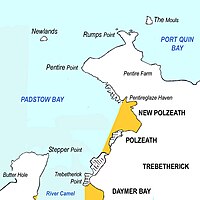Difference between revisions of "Pentire Head"
m |
m (clean up, typos fixed: , → ,) |
||
| Line 18: | Line 18: | ||
==For The Fallen== | ==For The Fallen== | ||
[[File:ForTheFallenPlaqueCornwall.jpg|right|thumb|170px|Plaque commemorating Laurence Binyon]] | [[File:ForTheFallenPlaqueCornwall.jpg|right|thumb|170px|Plaque commemorating Laurence Binyon]] | ||
| − | The poet [[Laurence Binyon]] wrote ''For The Fallen'' while sitting by the cliffs between Pentire Point and The Rumps ,and a stone plaque was erected in 2001 to commemorate it. ''For The Fallen'' was written at the beginning of the Great War, in September 1914, and is read in churches every Remembrance Sunday: | + | The poet [[Laurence Binyon]] wrote ''For The Fallen'' while sitting by the cliffs between Pentire Point and The Rumps, and a stone plaque was erected in 2001 to commemorate it. ''For The Fallen'' was written at the beginning of the Great War, in September 1914, and is read in churches every Remembrance Sunday: |
<blockquote><poem>They shall grow not old, as we that are left grow old | <blockquote><poem>They shall grow not old, as we that are left grow old | ||
Latest revision as of 17:34, 1 February 2016
Pentire Head (SW934802) is a headland and peninsula on the Atlantic coast in northern Cornwall, a headland about one mile square. The headland projects northwest with Pentire Point at its north-west corner and The Rumps promontory at its north-east corner.
The name "Pentire" is from Cornish penn tir, simply meaning "head of land". Another headland with the name Pentire is further west near Crantock.
Geography
Pentire Point and Stepper Point stand at either side of the mouth of the River Camel estuary (Pentire to the northeast, Stepper to the southwest). To the south of Pentire Point is the small seaside resort of Polzeath. The coastline around the headland is owned by the National Trust, although the bulk of the headland itself is let to Pentire Farm.
The Rumps promontory is the site of Iron Age clifftop fortifications - the series of mound and ditch earthworks remain clearly visible today.
The entire headland forms the Pentire Peninsula Site of Special Scientific Interest, designated for its geology and flora and fauna including nationally rare plants. Important examples noted include slates from the Upper Devonian period, several invertebrate species, predatory birds and grey seals.[1]
A small island named Newland lies about a mile to the northwest of Pentire Point. Another small island named The Mouls lies 300 yards to the north-east of The Rumps and supports colonies of seabirds. Beyond The Rumps, the coastline veers southeast into Port Quin Bay.
The South West Coast Path closely follows the coastline of the headland, and sightseeing boat tours regularly travel along the coast from the nearby port of Padstow.
For The Fallen
The poet Laurence Binyon wrote For The Fallen while sitting by the cliffs between Pentire Point and The Rumps, and a stone plaque was erected in 2001 to commemorate it. For The Fallen was written at the beginning of the Great War, in September 1914, and is read in churches every Remembrance Sunday:
They shall grow not old, as we that are left grow old
Age shall not weary them, nor the years condemn
At the going down of the sun and in the morning
We will remember them.
Pictures
The view from Pentire Point, looking towards Polzeath and Trebetherick Point.
Outside links
- Pentire Point at Polzeath
- Photographs and information from Strolling Guides
References
- ↑ "Pentire Peninsula". Natural England. 17 September 1986. http://www.sssi.naturalengland.org.uk/citation/citation_photo/1004161.pdf. Retrieved 25 October 2011.










